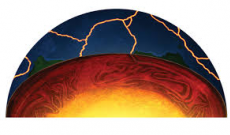

Earthquakes
The power of an earthquake is measure using a seismometer. A seismometer is a sensitive machine, which picks up the vibrations caused by the earthquake. It plots these vibrations on a seismograph. The strength, or magnitude, of an earthquake is measured using a scale called the Richter scale, numbered from 0-10. 1 would be a small earthquake, 7-10 is a devastating earthquake.
Hekla, Iceland Case Study
Background information to Hekla’s 2000 eruption
An eruption began in the Hekla volcano at approximately 18:17 on the 26th of February 2000
The timing of the eruption is based on a decrease in strain build-up rate recorded in the Hekla volcanic vent by a strain meter located in a borehole about 15km from the volcano summit
An active volcano for centuries, Mount Hekla is one of the most famous in the world
Over the past 700 years, Hekla has had 5 big fissure eruptions
The impacts of the eruptions
Social
finding the animals dead effects farmers jobs as well food supplies
Most ash fell in uninhabited areas
Environmental
the lava flows down the slopes of Hekla and covers a large part of the Hekla ridge
Farmers were worried because several animals died
Economic
most of the ash fell in uninhabited areas in the interior of Iceland
Money for food and crop replacements needed
Food was poisoned by ash and other volcanic debris.
Management of hazard
Planning protection
the seismic networks of the science institute of Ic eland recorded a short-term precursory earthquake activity
A seismograph near the summit of Hekla beginning at 1700 detected small earthquakes
Prediction
the national civil defence of Iceland issued a warning and the public was alerted.
Thunder, lightening and earth tremors accompanied the eruption
A discontinuous curtain of fire emanated from the entire fissure
MEDC
Medium-sized buildings are constructed using devices that act like shock absorbers between the building and its foundation. These devices- known as ‘base isolators’ are usually bearings made of alternating layers of steel and an elastic material, such as synthetic rubber. Base isolators absorb some of the energy of an earthquake- flexibility is the key.
All heavy appliances, furniture and other structures should be fastened down to prevent them from falling. Gas and waterlines must. Be specially reinforced with flexible joints to prevent breaking. Fire, fuelled by broken gas pipes, is a real risk after earthquakes.
In the developing world, all of these methods are used, especially for important buildings in the central business districts and in the richer areas of cities. Elsewhere in the developing world, however, money is rarely available for expensive engineering solutions and simple ways of strengthening existing buildings and new buildings are used. Skyscrapers need special construction to make them earthquake resistant. The foundations need to very deep. They need a reinforced framework with stronger joints than those used in an ordinary skyscraper.
One of the main ways of mitigating the impact of an earthquake is to improve building design. Engineers have developed ways to build earthquake resistant structures- not just houses, but office blocks and bridges too. The methods range from extremely simple to complex. For small-to medium sized building, the simpler reinforcement techniques include bolting buildings.
Image- https://www.earthmagazine.org/article/when-and-how-did-plate-tectonics-begin-earth

0 Comment:
Be the first one to comment on this article.